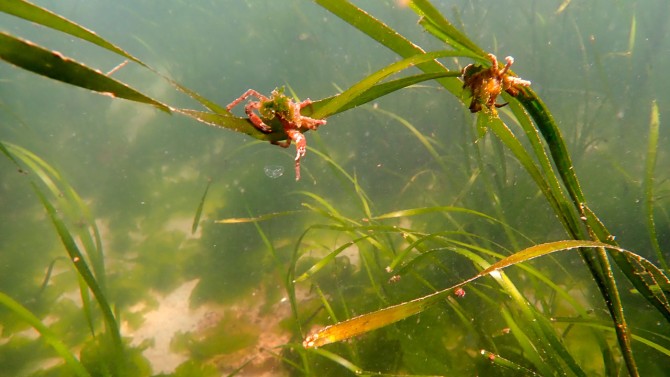A combination of ecological field methods and cutting-edge artificial intelligence has helped an interdisciplinary research group detect eelgrass wasting disease at nearly three dozen sites along a 1,700-mile stretch of the West Coast, from San Diego to southern Alaska.
The key finding: Seagrass wasting – caused by the organism Labyrinthula zosterae and detectable via lesions on the grass blades, confirmed with molecular diagnostics – is associated with warmer-than-normal water temperatures, particularly in early summer, regardless of the region. Eelgrass is a vital coastal species of seagrass for fish habitat, biodiversity, shoreline protection and carbon sequestration.
The Cornell research team – led by Carla Gomes, the Ronald C. and Antonia V. Nielsen Professor of Computing and Information Science in the Cornell Ann S. Bowers College of Computing and Information Science, and Drew Harvell, professor emeritus in the Department of Ecology and Evolutionary Biology (College of Agriculture and Life Sciences; College of Arts and Sciences) – reported their findings May 27 in Limnology and Oceanography.
Sea creatures cling to blades of eelgrass at False Bay Biological Preserve, Washington.
Co-lead authors are Brendan Rappazzo, M.Eng. ’18, a doctoral student in computer science, and Lillian Aoki ’12, a former postdoctoral researcher in Harvell’s lab who’s now a research scientist at the University of Oregon. Ecology and evolutionary biology doctoral students Olivia Graham and Morgan Eisenlord also contributed.
Co-author J. Emmett Duffy of the Smithsonian Institution was lead investigator of a three-year, $1.3 million grant from the National Science Foundation (NSF), from which this research was born. The AI research and development was funded through an NSF Expeditions in Computing grant for computational sustainability; the initial collaboration between Harvell and the Smithsonian was developed as a Cornell Atkinson Center for Sustainability initiative.
Gomes, also director of the Institute for Computational Sustainability, and Rappazzo led the development of the Eelgrass Lesion Image Segmentation Application (EeLISA, pronounced eel-EYE-zah), an AI system that, when properly trained, can quickly analyze thousands images of seagrass leaves and distinguished diseased from healthy tissue.





.jpg?sfvrsn=97edde42_5)


